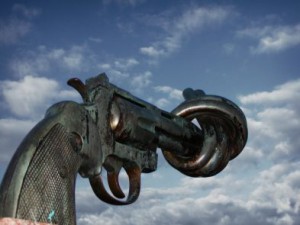
With all the conversation about the murders of the elementary students in Connecticut, the question of gun “control” is again being raised by actvists and politicians.
Suggestions range from micro-etching ammunition to posting armed guards at the schools. I want to suggest a couple of simple questions that should be asked to help evaluate any and all of these suggestions. Most suggestions involve changing the law, which is hard to un-do, and no matter what changes are made, there is always a downside. The current debate is useful and necessary.
The first question: If the proposal had been in force before the shootings, would it have stopped the shooter? If the goal is to “stop the tragedies”, then we must ask if the proposal would have done so in the case in Connecticut.
Most of the suggestions involving gun control would not have stopped this shooter. The guns used were violently seized from their rightful owner. The school was already “gun free”. The shooter likely could not have legally qualified to buy firearms. Most of the legal changes being suggested, like locking up guns, and being “careful” about who can acquire a gun would have done no good in this case.
There are lots of legal changes that sound like a “good idea”, or would give activists reason to claim to have “done something”, but would the proposal have actually prevented this tragedy?
Second question: As opposed to what?
This is a vital question that must always be asked. We must always measure the proposal versus the status quo, and versus other proposals that might be better.
There are thousands of schools in this nation. School massacres are unspeakable, but fortunately rare. Resources of all kinds are finite. We could put 30 foot concrete walls and a moat around every school. Even that might not have stopped this shooter, but the cost would be prohibitive in any case. (The shooter could still have shot his way in even with the most formidable defenses.)
Costs are always counted. We talk about a single life being so valuable that “no cost is too high”, but this is simply false. There are lots of examples, and this is one, where the amount of effort that we are willing to expend to get a job done is limited. This is because when we expend resources on one thing, they arealways taken at the expense of other efforts. If we spend $5 billion dollars building walls and moats, that is $5 billion that we don’t have to spend on TSA or military salaries or bank guards. Every choice weighs benefits and costs. Like it or not, the rarity of school killings factors into the effort we are willing to expend to prevent them. It appears that something should be done, but whatever it is, it must be measured and balanced against the costs.
Measuring the cost might seem callous, but is not optional. Costs always matter.
Lastly, I want to put in a word about the atmosphere in schools.
I travelled in Europe in mid 1980s, when the US airports had not yet become armed camps, and Europe was struggling with the Red Brigades and the PLO. When I saw German guards in the airports with grim expressions and loaded machine guns, I did not feel safer. It did not give me a desire to “hang out” in the airports.
That said, I’m glad the Europeans acted firmly. They ended up catching the Red Brigades, and I think in the end the armed guards did their jobs, but it was an unfortunate measure, costly in multiple ways.
I agree with those who insist that you must fight fire with fire. The only truly effective way to stop an armed murderer is an adequately armed “good guy”. Further, being the “good guy” seldom can be delegated to “someone else”.
I want our schools to become safer, but I do not want to have our school children surrounded by armed guards, or metal detectors. There is value in the low-key atmosphere they have today, and that is worth preserving. The challenge is to do this and also improve security, and at appropriate cost.
Maybe one solution would be to find the people like this shooter who are running around loose, and get them off the street before they have a chance to do more harm.
Would this have stopped the tragedy in Connecticut? Let’s count the cost….

